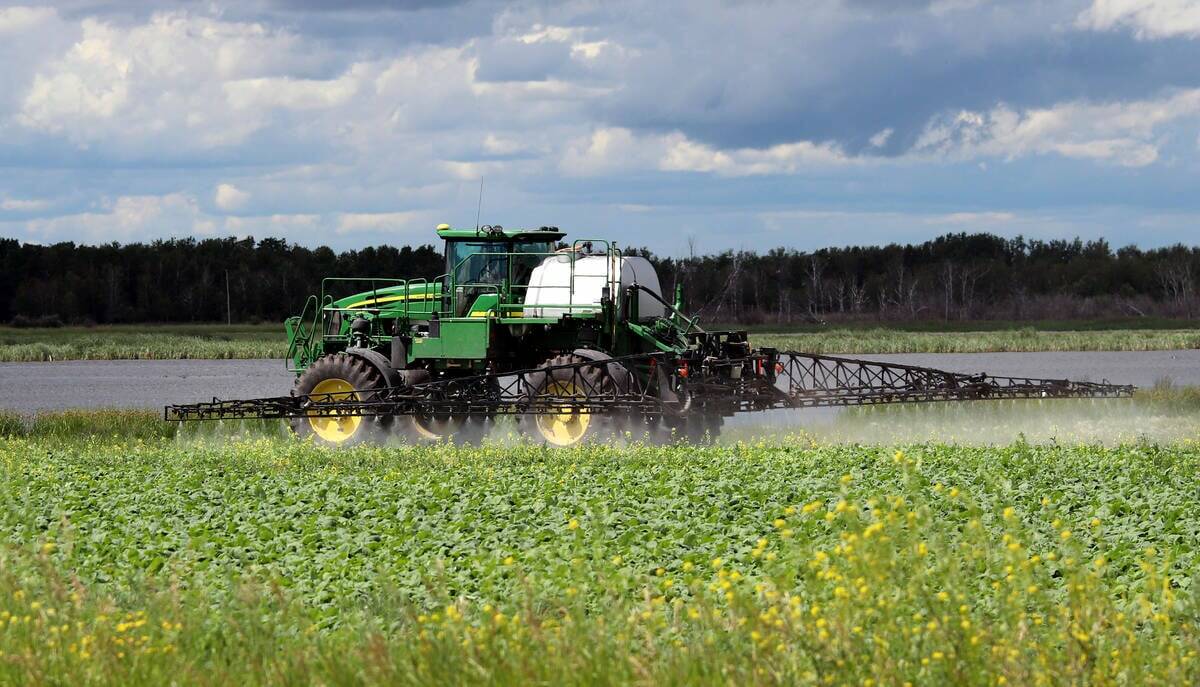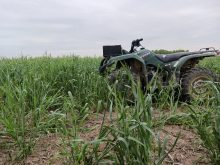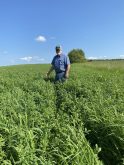The soil on Ken Mitchell’s alfalfa and corn fields looked good on paper but the reality was less than stellar in terms of production.
The 100-acre block was the focus of the Grey County Soil and Crop Improvement Association crop tour in late July. It looked at how marrying new technology with tried-and-true soil assessment methods reveals vital challenges and solutions in the soil.
Why it matters: Combining new-age tech with test results from soil pits provides a more complete view of soil health challenges that can result in an effective soil management strategy.
Read Also

Smart fertility planning key to soybean yields
Understanding how to tailor fertilizer plans to specific field conditions will be critical for a successful 2026 soybean crop.
“(This) was wheat last year, cover crop oats, and then we had 30 cows on it for about a month and 60 cows for three weeks after that,” Mitchell told tour participants. The field was grazed from September to November until it got too wet.
Despite an improvement after incorporating strip-till and cover cropping several years ago, Mitchell noticed uneven production from the east to the west side.
The corn is strip tilled and the cover crop Maasai beans are no-tilled right into the corn stalks. Mitchell put two rows of beans between the rows of corn, on 15-inch centres.
He uses dry fertilizer and plant with a Kinzie planter. For nitrogen, he broadcast 40 pounds of nitrogen before planting, then put on some with the starter fertilizer. It was topped up in mid-July with 20 to 22 gallons per acre of 28 per cent nitrogen applied using Y-Drops after taking soil and tissue samples.
“Even though you’ve got a better soil health rating, the corn isn’t growing as well,” said Jim Warren, soil chemist for the Ontario Ministry of Agriculture, Food and Rural Affairs. “That’s why we need to look a little deeper into the profile and effectively see what the problem is here.”
In June, Mitchell had Deb Campbell, of Agronomy Advantage, map the land and compose a complete soil diagnostic. They dug several soil pits for the tour’s benefit, to highlight the unique needs within individual zones.
“We did five soil tests on here ranging from zone one-two down to zone nine-10 in the first week of June before the corn was knee-high and soil sampled a week later in mid-June,” said Campbell.
Mapped as Harkaway soil, a clay-loam texture with 27 to 40 per cent clay, the soil pits revealed Kemble and Vincent silty-clay-loam. Mitchell plants using three- to four-inch strip till depth in a corn, soy and wheat rotation with an oat cover crop.
The cornfield pit soil is silty clay loam with a heavily compacted clay layer significantly denser than the alfalfa soil pit 20 feet to the south, where the roots have pierced the tile.
“It is so incredibly thick and so incredibly dense you don’t get the roots coming through,” said Warren about the corn’s profile. “They’re up in the AP horizon here, but as soon as you hit this (clay) layer, essentially, there’s nothing in there. In this case, it’s not a soil health problem, it’s a physical problem. A compaction problem.”
While it may not look wet, clay will hold significant moisture and create a compaction issue, explained Warren. A radish cover crop with a strong tap root would help drain the profile and alleviate the problem.
“In corn, basically the root is coming down and going out, and particularly in the summer, it’s not going to pick up any water,” he said.
Campbell noted loamy soils provide better production with natural drainage than the tiled acres.
The Soil, Water and Topography (SWAT) map split the field evenly using those parameters but later divided the land into five zones, allowing more accurate mapping.
According to Campbell, initial results showed the soil pH was critically low at 5.8/5.9 in some zones and low at 6.1/6.2 in others, which limits soybeans and alfalfa.
Because magnesium levels were soft, Campbell advised Mitchell to apply dolomitic lime at a low and high rate based on the zone ratings to create an immediate change.
SWAT information could be used to create a management plan that marries Mitchell’s strip-till and cover crop practices. Over time, that would enhance porosity through root structures and target areas that would benefit from more organic matter.
Jake Munroe, OMAFRA field crop soil management specialist, discussed the pros and cons of integrating numerous cover crop varieties, including oats for forage, oats and tillage radish, triticale, sorghum-Sudan grass, pearl millet, annual ryegrass, forage turnip, and buckwheat.
The evaluations include forage value, nitrogen scavenging levels and efficiency at combating soil erosion. Annual ryegrass got top marks with four stars across the board, followed by forage oats and pearl millet with three stars. The others often excelled in one or two areas but struggled in others.
Oats have value in a cover crop
“Oats are kind of a no-brainer (for a cover crop.) They’ve got a really good root system that pairs really well with manure,” said Munroe.
He said recent research through the University of Guelph’s long-term cover crop trial indicates oats may carry nitrogen forward to the following crop.
The trial compared straight oats to red clover and some mixes, with each plot split to compare no nitrogen to 50 pounds of nitrogen to see how well the corn grows.
“Traditionally, we haven’t considered you would get a nitrogen credit in any way from a non-legume crop,” Munroe said.
“But for those of you who’ve got manure and are seeding a cover crop, there is a hint the oats at least could be doing a decent job of not only taking that nitrogen up but supplying it to the following corn crop. So stay tuned.”
Campbell said it’s never one factor that fixes an issue, but instead stacking solutions, whether that means adding organic material, minerals, cover crops or and minimizing tillage.
“At the end of the day, the limiting factor in this field is not necessarily soil health. It’s drainage, which is affecting soil health,” she said. “We’ve got a nice topsoil here. I am surprised that it came back with beautiful soil health,” considering the issues with crop growth.













